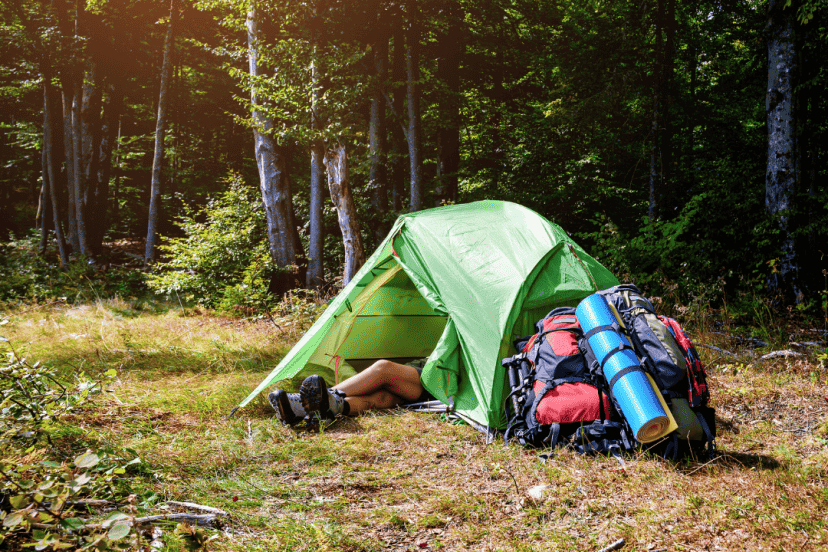Best Weight For Backpacking Tent: Choosing The Right Tent
Understanding Backpacking Tents: An Overview
Backpacking tents are a vital component of outdoor expeditions, designed specifically for the needs and constraints of long-distance hikers, backpackers, and mountaineers. Their fundamental properties revolve around portability, compactness, and burden reduction. The weight for a backpacking tent is an especially crucial factor because it directly impacts the overall load a hiker must carry.

Variations in weight among different tent models are often associated with the tent’s capacity, material, structural design, and other add-on features. Lighter tents usually come with trade-offs, such as reduced space or less durable materials, while heavier ones, though offering more comfort and robustness, could be physically demanding to carry over extended distances. Thus, it becomes essential to strike a careful balance that corresponds best with individual requirements and the nature of the backpacking trip.
Key Factors to Consider when Choosing a Backpacking Tent
When embarking on a backpacking trip, the selection of your gear, and most importantly your tent, can make or break your experience. Thus, it is critical to pay attention to some key aspects before settling on a backpacking tent. Consider factors like the tent’s weight, its degree of resistance to various weather conditions, compatibility with the trip terrain, and the lifespan of the tent. After all, a tent that is feather-light but rapidly deteriorates won’t do much good in the long run, nor would a tent that applies excessive load on your back but withstands harsh conditions serve the purpose of a comfortable trip.

Another point to deliberate upon, is the size and capacity of the tent. It must be spacious enough to accommodate you and any other people you’re sharing with, as well as your gear. Nonetheless, remember that a larger tent might also mean more weight. Additional essential features like easy setup, ventilated material, and durability should also be kept in mind. Furthermore, the affordability of the tent is a crucial aspect that mustn’t be overlooked when deciding upon the perfect backpacking tent. Therefore, when hiking or backpacking, the ideal tent is not only dependent on personal preference but should be a harmonious balance between these determining factors.
The Role of Material and Design in Tent Heaviness
Materials used in tent construction significantly impact the overall weight of the product. Commonly, nylon and polyester are chosen for their lightness and durability. They are also widely preferred because of their inherent ability to resist rot and harmful UV rays. Ripstop versions of these fabrics are often utilized due to their quality of preventing tears from spreading, providing an additional layer of durability without significantly adding to the overall weight.
Conversely, the design of a tent plays a crucial role in its weight. For instance, freestanding tents, which need less stake and guyline support, are generally lighter; however, they may not withstand harsh conditions as well as their more robust counterparts. Double-wall tents include an inner body and a rainfly, offering excellent ventilation and protection from rain but at a higher weight. On the other hand, single-wall tents save weight by eliminating the inner body, but condensation may become an issue. Thus, the choice between different materials and designs boils down to a balance between tent weight, durability, and weather resistance.
Examining the Trade-off: Lightweight Tent vs Durability
One of the key considerations when selecting a backpacking tent is striking a balance between the lightweight aspect and durability. The desire to reduce the burden on one’s back often prompts backpackers to pick the lightest items available. However, when it comes to tents, it’s prudent to reckon with the need for durability. A seemingly minor compromise on durability could escalate into a significant challenge in scenarios such as storms or encounters with wildlife.
Lightweight tents are often constructed from thin, high-tech materials which, while saving on weight, may not be as resilient as their heavier counterparts. On the other hand, more durable tents are typically made from thicker materials, which can add considerable weight. Thus, when purchasing a tent, it’s essential to verify the durability of lightweight options or assess whether a slightly heavier, robust tent might be a better fit for the intended use, especially if tough weather conditions are anticipated.
How Weather Conditions Impact Your Tent Choice
Weather conditions play a crucial role in the selection of your backpacking tent. The local climate of your destination significantly impacts your choice. If you are heading towards dramatic and unpredictable weather conditions, it’s essential to opt for a four-season tent, designed to withstand heavy rain, snow, and high winds. These tents are constructed with strong, durable materials, feature a dome-like structure for better wind resistance, and typically contain a rainfly and vestibule for added protection.
On the other hand, for backpacking in milder conditions where the primary concern is keeping bugs out and having a shield against occasional showers, a three-season tent is generally sufficient. These tents are lightweight, less bulky, and provide good ventilation, making them suitable for spring, summer, and fall. Therefore, the geographical conditions at your backpacking destination and the prevalent weather patterns significantly influence your tent choice.
Importance of Tent Size and Capacity for Backpackers
Tent size and capacity play a crucial role each time a backpacker embarks on an adventure. The size of the tent is directly proportionate to the comfort it offers – a larger tent means more space for you and your gear. Similarly, the capacity of a tent refers to the number of people it can shelter. This becomes important when you are backpacking in a group; you need a tent that can house everyone comfortably.
However, remember that a larger tent will also add to the weight of your backpack. It’s here that a backpacker must strike a balance between comfort and weight. While a more spacious tent might provide better comfort, it may also require more time and effort for setup. Ultimately, the choice greatly depends on your backpacking style, personal comfort preferences, and the nature of your trek.
Essential Features of a Lightweight Backpacking Tent
When evaluating various backpacking tents, there are a few key features that should not be overlooked. Firstly, ventilation is crucial – look for mesh panels in the tent body to ensure breathability, which will reduce condensation and thereby enhance your comfort. The presence of multiple doors can also enhance convenience, as it allows campers easier access without having to clamber over each other.
An equally important feature of a lightweight backpacking tent is its quick and easy set-up process. A tent that is difficult to pitch can drain your energy and take away valuable relaxation or exploration time. In a similar vein, the packing process should be straightforward, enabling you to hit the road quickly. Another critical feature is the tent’s structure and stability, as it should be able to withstand strong winds during your backcountry adventures. Finally, don’t forget the tent’s footprint; while it may add a little weight, it can significantly extend the tent’s lifespan by protecting it from rough ground.
The Impact of Tent Weight on Backpacking Experience
One of the significant factors impacting the backpacking experience is the weight of the tent. This everyday item, vital for a camper’s outdoor shelter needs, can pose an enormous strain if not selected thoughtfully. A heavier tent can make the journey strenuous by adding extra load to the backpack, quickly leading to fatigue. This is especially relevant for long-distance trekkers or hill climbers, where each ounce in weight counts and can directly affect performance and pace.
On the contrary, a lightweight tent is easier to transport and generally increases mobility and comfort during the trek. It saves energy, allows travelers to cover more ground, and can make the entire backpacking experience more pleasant. However, it’s important not to overlook the durability and functionality of the tent in the quest to reduce weight. A well-balanced approach considering both weight and resilience is necessary in choosing the right backpacking tent.
Reviewing Top Lightweight Tents in the Market
In the arena of backpacking tents, there are several options that stand out for their impressive lightweight construction. First, we have the MSR Hubba Hubba NX 2-Person Tent, which is renowned for its combination of comfort, light weight, and durability. The tent tips the scale at just 3.5 pounds, and despite this featherweight class, it exhibits exemplary resistance against harsh weather conditions. Its livability is uncompromised with a spacious interior and twin vestibules for gear storage.
Another noteworthy entrant is the Big Agnes Copper Spur HV UL1 Tent. As a one-person tent, it offers an impressive space-to-weight ratio and is known for its easy set-up process. Weighing around 2.2 pounds, it is designed with ultralight backpacking in mind. The tent highlights a strong and lightweight fabric, unique to Big Agnes, enhancing its durability. With a spacious vestibule, it not only grants enough room for a backpacker but also a storage space for gear and boots.
Practical Tips to Reduce the Load of Your Backpacking Tent
In the quest for a lighter backpack during an outdoor escapade, selecting a lightweight tent is just the first step. The real challenge arises when packing and carrying it. One practical tip to significantly reduce tent weight is adopting the concept of ‘sharing is caring.’ If you are traveling in a group, consider dividing the tent components among the group members. One can carry the poles while another takes the tent body. This not only distributes the weight evenly but also fosters teamwork and cooperation among the group.
Another important strategy is to pay attention to the items that accompany your tent. Often many tents come with extra stakes, guylines, or even a footprint. Be mindful of what is essential and what is not. For instance, in a place with lots of trees or natural tie-off points, carrying extra guylines or stakes can be avoided. Observing these practical tips can significantly reduce the load of your backpacking tent, making your journey more comfortable and enjoyable.
What are the key factors to consider when choosing a backpacking tent?
The key factors to consider when choosing a backpacking tent include the material and design, the weight, the weather conditions it can withstand, its size, and capacity, and the features it offers.
How does the material and design of a backpacking tent contribute to its weight?
The material of the tent is a major factor in its weight. For example, tents made from lighter materials like nylon are typically lighter than those made from heavier materials like polyester. The design of the tent can also affect its weight, with simpler designs typically being lighter than more complex ones.
Can a lightweight tent be durable?
Yes, a lightweight tent can be durable, but there is often a trade-off between weight and durability. Lightweight tents are usually made from thinner materials which may be less durable than heavier materials. However, by taking good care of your tent, you can extend its lifespan.
How do weather conditions impact my choice of a backpacking tent?
Weather conditions play a significant role in the choice of a tent. If you’re backpacking in a region with heavy rainfall, you’ll need a tent with good waterproofing. For windy conditions, a tent with strong poles and secure guy-lines is essential. In colder climates, a tent with good insulation is needed.
Why is the size and capacity of the tent important for backpackers?
The size and capacity of the tent are important because they determine how much space you have for yourself and your gear. It’s also important to consider how many people will be sleeping in the tent. A tent that is too small can be uncomfortable and claustrophobic.
What are some features of a lightweight backpacking tent?
Some features of a lightweight backpacking tent may include simple designs with fewer poles and stakes, use of lightweight materials such as nylon or thin polyester, minimalist interior features, and compact packing size.
How does the weight of the tent impact the backpacking experience?
The weight of the tent can greatly impact the backpacking experience. A heavier tent can make your pack feel weighty and can lead to fatigue more quickly. On the other hand, a lighter tent can make backpacking more enjoyable by reducing the burden on your back.
Can you suggest some top lightweight tents in the market?
Some top lightweight tents in the market are the Big Agnes Copper Spur HV UL2, the REI Co-op Quarter Dome SL 2, and the Nemo Hornet Ultralight.
Do you have any practical tips to reduce the load of my backpacking tent?
Yes, you can reduce the load of your backpacking tent by choosing a tent made from lightweight materials, opting for a simpler design, and only bringing the necessary tent components. You could also share the load with a partner by dividing the tent components between you.




